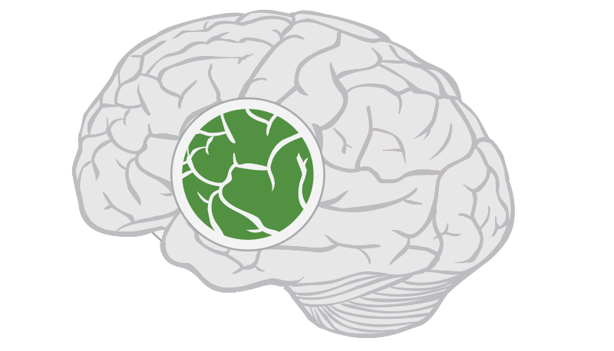Situated deep within the folds of the cortex—the outer layer of the cerebrum—lies the insular cortex. Sometimes called the insula, insulary lobe, or insulary cortex, this brain region remains something of a mystery. Its location deep within the brain makes it difficult to explore, and until recent decades, doctors had little understanding of its purpose. That's changing, thanks in part to better brain imaging technologies, but much remains to be understood about this vital brain structure.

Where is the Insular Cortex?
To understand the insular cortex's location, you must first understand a bit about brain anatomy. All mammals, including humans, have a cerebral cortex. This outermost layer of the brain is relatively new, evolutionarily speaking, and houses a range of brain regions associated with cognition, emotion, and other complex behaviors and thoughts.
Located within the cerebral cortex is an organ known as the lateral sulcus. Sometimes called the Sylvian fissure, this brain region separates the frontal, parietal, and temporal lobes of the brain. The insular cortex is situated inside of the Sylvian fissure. The insular cortex is overlain by the brain's operculum, which is formed from portions of the frontal, parietal, and temporal lobes. Though the insular cortex is far from the deepest region of the brain, it has proven difficult for researchers to explore until recently.
That all changed with the research of famed neuroscientist Antonio Damasio, who hypothesized that the insular cortex plays a key role in mapping somatic states. Neuroscientists now divide the insular cortex into two distinct regions: the large anterior insula, and the small posterior insula. Researchers have identified more than a dozen regions to the posterior insula.
What Does the Insular Cortex Do?
The insula's role in somatic states means that it provides an emotional context for physiological experiences. In other words, it gives meaning to bodily states by, for example, helping you experience pain as unpleasant. Like most brain regions, though, the insular cortex is not limited to a single function. It plays a role in a variety of functions. Given the extremely important role of physical experiences in cognition, damage to the insular cortex can affect virtually every component of physiological and psychological functioning.
So far, researchers have linked the insular cortex to:
- Perception of pain.
- Basic emotions, including joy, happiness, anger, and disgust.
- Addiction and other conscious desires. Thus damage to the cingular cortex may alter behavior, particularly compulsive behaviors such as shopping or gambling.
- Interoceptive awareness—your ability to be consciously aware of bodily states, such as heart beat. Interoceptive awareness plays a key role in homeostasis, which is vital for survival.
- Motor control.
- The sense of self; for centuries, philosophers and scientists have tried to understand where our perception of ourselves as unique beings originates. We now know that the insular cortex may help us establish a sense of ourselves as constant entities separate from the rest of the world.
- Reading emotions and social cues.
In humans and great apes such as gorillas and chimpanzees, the insula has a number of modifications that hint at the unique capacities of primates. First, this brain region's anterior portion is more highly developed in primates than in other animals, which might explain why primates tend to have strong social relationships, a sense of self, and high attunement to their own bodily states.
Humans and great apes have developed a unique neuron in their insula. Long, cigar-shaped nerves known as von Economo neurons (VENs) are thought to play a key role in the formation of social relationships, reading social cues, and other functions vital to both humans and their great ape cousins. Put simply, VEN neurons may play a significant role in what makes us human, and certainly in the incredible social skills that differentiate us from other mammals.
How the Insular Cortex Works With Other Structures
Guides to brain functioning often label a single region as “for” a specific function, creating the illusion that there is a simple one-to-one correlation between the two regions. This is misleading. Though the insula plays a significant role in pain perception, social engagement, empathy, emotions, and numerous other vital functions, it is far from the only brain region that contributes to these functions.
Moreover, it must work with other brain regions—and other parts of the body—to properly function. This means that damage to any area of the body with which the insula interacts can impede the functions of the insula. For example, issues with hormone production could impede brain function even when the brain structure in question is fully intact.
Most research points to a strong connection between the insula and the limbic system. A number of structures in the insula either connect to or send signals to portions of the limbic system, suggesting a key relationship between the two. The limbic system is a set of structures, including brain regions such as the amygdala and hippocampus, which play a role in motivation, memory, and learning.
Because of its important role in these functions, the limbic system can affect relationships, in addition to playing a role in the development of mental illness. The limbic system may also play a role in unconscious processes. For instance, people who repeat damaging behavior patterns—such as compulsive gambling or excessive neediness—may be repeating patterns established by early experiences and solidified by the functions of the limbic system.
How Damage to the Insular Cortex Can Affect Functioning
Damage to the insula can be far-reaching and catastrophic. Conversely, its effects may also be minimal. Sometimes the brain finds ways to work around and compensate for injuries, and much depends on the severity of the injury, what caused it, quality of treatment, and the age at which the injury occurred. Seniors, for instance, typically require longer to recover from brain injuries and have a poorer prognosis than healthy young people. Only a doctor can give you a clear prognosis.
Generally speaking, though, dysfunction in the insula can trigger:
- Difficulties with sensory perception, especially touch, taste, sound, and smell.
- Bodily awareness.
- Perception of pain; you might stop feeling pain, or might feel pain when there is no actual source to the pain.
- Addiction.
- Language difficulties.
- Emotional imbalances, particularly with emotions such as disgust and anger.
- Difficulties with social relationships.
- Symptoms of mental illness.
- In children, developmental delays.







